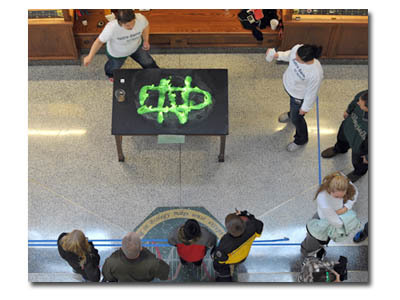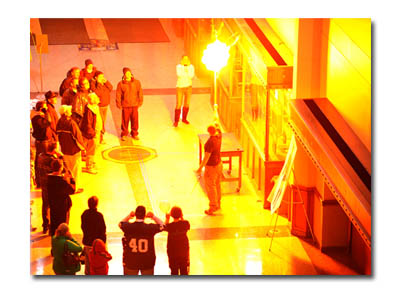
Graduate, undergraduate students and professional specialist faculty in the Department of Chemistry and Biochemistry provided vivid demonstrations and hands-on experiments on Saturday, October 24 in celebration of National Chemistry Week. The inaugural event, held in the Jordan Hall of Science Galleria, attracted a steady stream of visitors before the Notre Dame-Boston College football game. Exploding balloons, bright-colored flame tests, and green-burning boric acid drawings of shamrocks and the ND monogram acquainted people with an elementary understanding of science.
Michelle Bertke, a second-year Chemistry and Biochemistry graduate student who organized the event with outreach coordinator Karen Morris and fourth-year graduate student Brian Gloor explained, “We’re working across the Periodic Table.” From north to south in the Galleria, stations featured nonmetals, transition metals, inner transition metals and main group metals.

At the nonmetals exhibit, graduate students, including Jeff Bertke, a third-year graduate student, applied flame to balloons filled with hydrogen, helium and a mix of hydrogen and oxygen. Occasional booms filled the Galleria as the hydrogen-oxygen mix produced water and energy. Main Group Metals exhibitors sprayed solutions of metal ions into a flame. This classic experiment identified barium when the flame turned green, sodium with orange, strontium with red and potassium with purple. The table featured a silicon wafer borrowed from Chemistry professor Marya Lieberman and sound chips that would play the Notre Dame fight song.
At a station on transition metals, visitors learned why the Statue of Liberty is green – the original copper, exposed to nitric acid from acid rain, has coated the statue with a green film of copper nitrate. They also saw the effects of magnetism on iron filings, and in another section they saw the remains of copper-plated pennies made after 1983 with their zinc core dissolved by hydrochloric acid while older all-copper coins remained intact. At the station on inner transition metals, a Geiger counter demonstrated the radioactivity of common household items such as a radium clock dial, smoke detector and bright orange Fiestaware bowl. “This is chemistry, but this is fun,” Michelle Bertke said. “It’s more the ‘wow’ factor.”